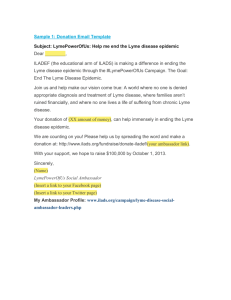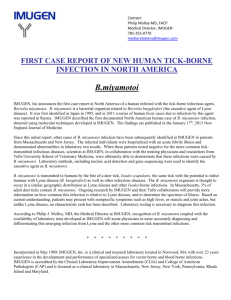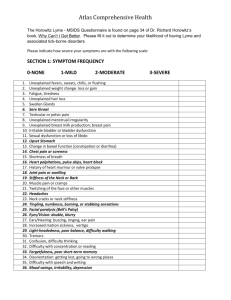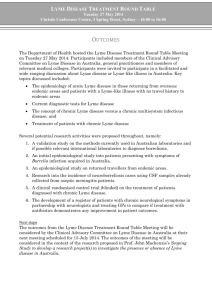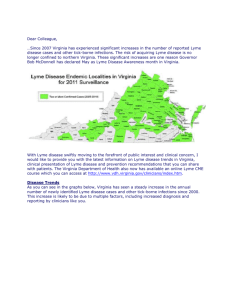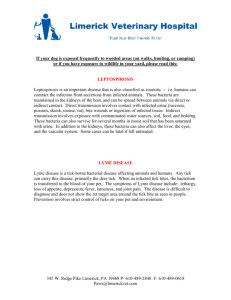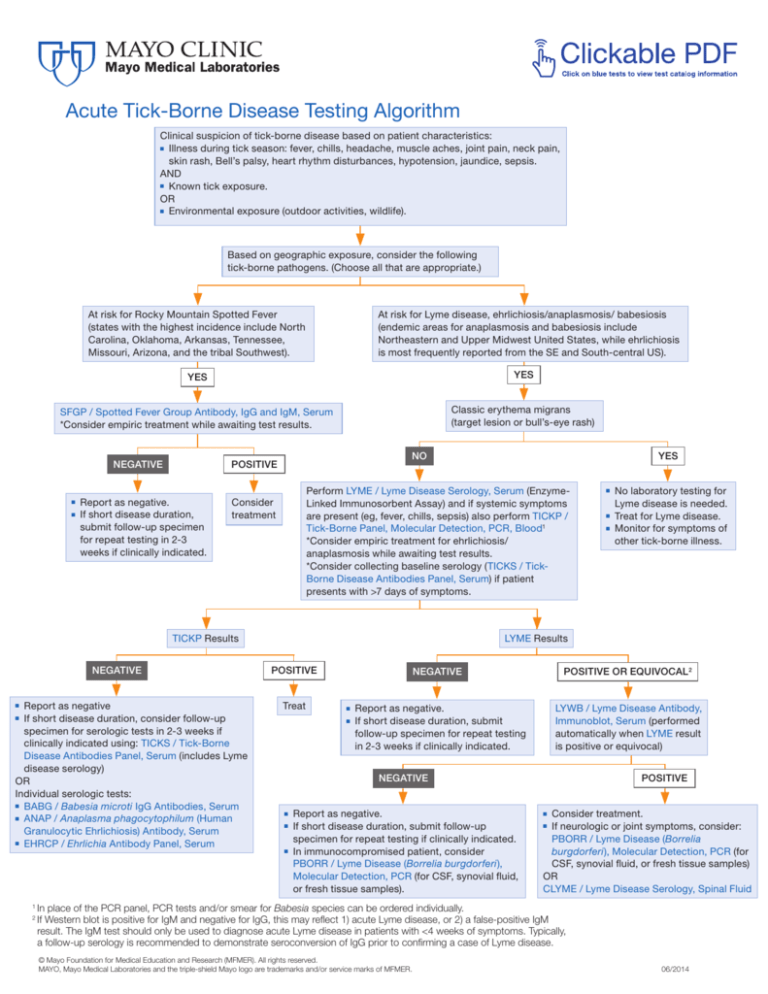
Acute Tick-Borne Disease Testing Algorithm
Clinical suspicion of tick-borne disease based on patient characteristics:
■ Illness during tick season: fever, chills, headache, muscle aches, joint pain, neck pain,
skin rash, Bell’s palsy, heart rhythm disturbances, hypotension, jaundice, sepsis.
AND
■ Known tick exposure.
OR
■ Environmental exposure (outdoor activities, wildlife).
Based on geographic exposure, consider the following
tick-borne pathogens. (Choose all that are appropriate.)
At risk for Rocky Mountain Spotted Fever
(states with the highest incidence include North
Carolina, Oklahoma, Arkansas, Tennessee,
Missouri, Arizona, and the tribal Southwest).
At risk for Lyme disease, ehrlichiosis/anaplasmosis/ babesiosis
(endemic areas for anaplasmosis and babesiosis include
Northeastern and Upper Midwest United States, while ehrlichiosis
is most frequently reported from the SE and South-central US).
YES
YES
SFGP / Spotted Fever Group Antibody, IgG and IgM, Serum
*Consider empiric treatment while awaiting test results.
Classic erythema migrans
(target lesion or bull’s-eye rash)
NEGATIVE
■
■
NO
POSITIVE
Report as negative.
If short disease duration,
submit follow-up specimen
for repeat testing in 2-3
weeks if clinically indicated.
Perform LYME / Lyme Disease Serology, Serum (EnzymeLinked Immunosorbent Assay) and if systemic symptoms
are present (eg, fever, chills, sepsis) also perform TICKP /
Tick-Borne Panel, Molecular Detection, PCR, Blood1
*Consider empiric treatment for ehrlichiosis/
anaplasmosis while awaiting test results.
*Consider collecting baseline serology (TICKS / TickBorne Disease Antibodies Panel, Serum) if patient
presents with >7 days of symptoms.
Consider
treatment
TICKP Results
NEGATIVE
Report as negative
If short disease duration, consider follow-up
specimen for serologic tests in 2-3 weeks if
clinically indicated using: TICKS / Tick-Borne
Disease Antibodies Panel, Serum (includes Lyme
disease serology)
OR
Individual serologic tests:
■ BABG / Babesia microti IgG Antibodies, Serum
■ ANAP / Anaplasma phagocytophilum (Human
Granulocytic Ehrlichiosis) Antibody, Serum
■ EHRCP / Ehrlichia Antibody Panel, Serum
■
2
■
■
■
No laboratory testing for
Lyme disease is needed.
Treat for Lyme disease.
Monitor for symptoms of
other tick-borne illness.
LYME Results
POSITIVE
Treat
■
1
YES
NEGATIVE
■
■
POSITIVE OR EQUIVOCAL2
Report as negative.
If short disease duration, submit
follow-up specimen for repeat testing
in 2-3 weeks if clinically indicated.
LYWB / Lyme Disease Antibody,
Immunoblot, Serum (performed
automatically when LYME result
is positive or equivocal)
NEGATIVE
■
■
■
Report as negative.
If short disease duration, submit follow-up
specimen for repeat testing if clinically indicated.
In immunocompromised patient, consider
PBORR / Lyme Disease (Borrelia burgdorferi),
Molecular Detection, PCR (for CSF, synovial fluid,
or fresh tissue samples).
POSITIVE
Consider treatment.
If neurologic or joint symptoms, consider:
PBORR / Lyme Disease (Borrelia
burgdorferi), Molecular Detection, PCR (for
CSF, synovial fluid, or fresh tissue samples)
OR
CLYME / Lyme Disease Serology, Spinal Fluid
■
■
In place of the PCR panel, PCR tests and/or smear for Babesia species can be ordered individually.
If Western blot is positive for IgM and negative for IgG, this may reflect 1) acute Lyme disease, or 2) a false-positive IgM
result. The IgM test should only be used to diagnose acute Lyme disease in patients with <4 weeks of symptoms. Typically,
a follow-up serology is recommended to demonstrate seroconversion of IgG prior to confirming a case of Lyme disease.
© Mayo Foundation for Medical Education and Research (MFMER). All rights reserved.
MAYO, Mayo Medical Laboratories and the triple-shield Mayo logo are trademarks and/or service marks of MFMER.
06/2014


